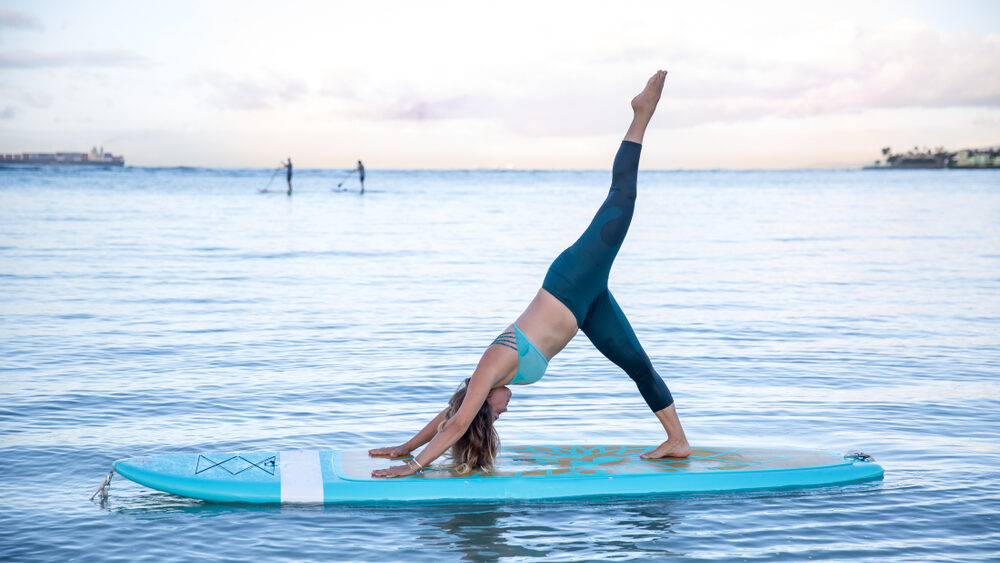Introduction
Embark on a journey of tranquility with paddleboard yoga, where the gentle lull of calm waters becomes the canvas for your yoga practice. Known as SUP (Stand-Up Paddleboard) yoga, this dynamic fusion elevates traditional yoga, demanding heightened balance and focus. Gliding through serene surroundings, the unstable paddleboard intensifies core engagement, sculpting strength and stability. The practice fosters mindfulness, enhanced by the soothing sounds of water. While challenges like instability and changing water conditions may arise, mastering paddleboard yoga brings numerous benefits—improved balance, coordination, and mental clarity. Discover the art of balance on the water, and let the serenity of paddleboard yoga guide you through a revitalizing and transformative experience.
- The Essence of Paddleboard Yoga: By practicing on a floating platform, paddleboard yoga elevates traditional yoga. The challenge is increased by the instability of the paddleboard, which forces users to use their core muscles for balance, stability, and focus. Yoga’s health benefits are combined with the calming effects of being near water in this unique and holistic experience, which is further enhanced by the gentle rocking of the board.

- Advantages of Paddleboard Yoga: Stability and Core Strength: Your core muscles must work harder because the water’s surface is always changing, which increases your strength and stability. Your lower back, obliques, and abdominal muscles will all become more toned and sculpted with paddleboard yoga, which will strengthen your body in preparation for other physical endeavors.
- Improved Mindfulness and Focus: Doing yoga poses while submerged in water requires increased mindfulness and focus. The requirement to remain in the present moment strengthens mindfulness, which encourages stress reduction and mental clarity. A deeper connection to your practice is fostered by the peaceful atmosphere created by the sound of the water gently lapping against the board and the gentle movement of the paddleboard.
- Enhanced Proprioception and Balance: Paddleboard yoga tests your balance and proprioception, improving your overall coordination. Your awareness of your body’s position in space increases as you get used to the surface beneath you that is always changing. This enhanced equilibrium carries over from the paddleboard into your everyday activities.
Challenges of Paddleboard Yoga:
- Instability: The main difficulty with paddleboard yoga is that the floating platform is inherently unstable. It can be difficult for beginners to stay balanced during poses, but with practice, people learn how to distribute their weight more evenly and find stability while moving.
- Water Conditions: Paddleboard yoga’s difficulty can be affected by elements like wind, currents, and water turbulence. It becomes even more difficult and unpredictable to practice in various water conditions, necessitating that practitioners modify their techniques to fit the constantly shifting surroundings.
Tips for Mastering Paddleboard Yoga:
- Select the Appropriate Board: Choose a wide, stable paddleboard, particularly if this is your first time. More surface area means greater stability on the water for boards made especially for yoga.
- Start with Basic Poses: Start your paddleboard yoga practice with basic poses like Warrior I, Mountain Pose, and Downward Dog. Gaining proficiency in these poses on a steady surface before moving on to more difficult ones on the paddleboard will increase your self-assurance and familiarity with the motions.
- Concentrate on Breath and Drishti: Throughout each pose, pay special attention to your breath and keep your gaze steady (Drishti). Anchoring your focus and promoting balance can be achieved by focusing on your breath and a stationary point on the horizon.
- Practice Falling: Accept that falling into the water is inevitable. By repeatedly falling off the board and getting back up, you can practice resilience and fear reduction, which will help you approach paddleboard yoga with a playful and adventurous mindset.

Conclusion
Embarking on a paddleboard yoga journey is a transformative experience that challenges both the body and mind. The combination of yoga and stand-up paddleboarding creates a harmonious blend of strength, balance, and mindfulness, providing a unique way to connect with nature and oneself. As you navigate the waters and explore various poses, the serenity found in paddleboard yoga transcends the physical realm, offering a profound sense of tranquility and inner peace. So, paddle out, find your balance, and let the waters be your guide to a serene and revitalizing yoga practice.
